Last Chance to Catch NYC's Holiday Notalgia Train
We met the voices of the NYC subway on our nostalgia ride this weekend!


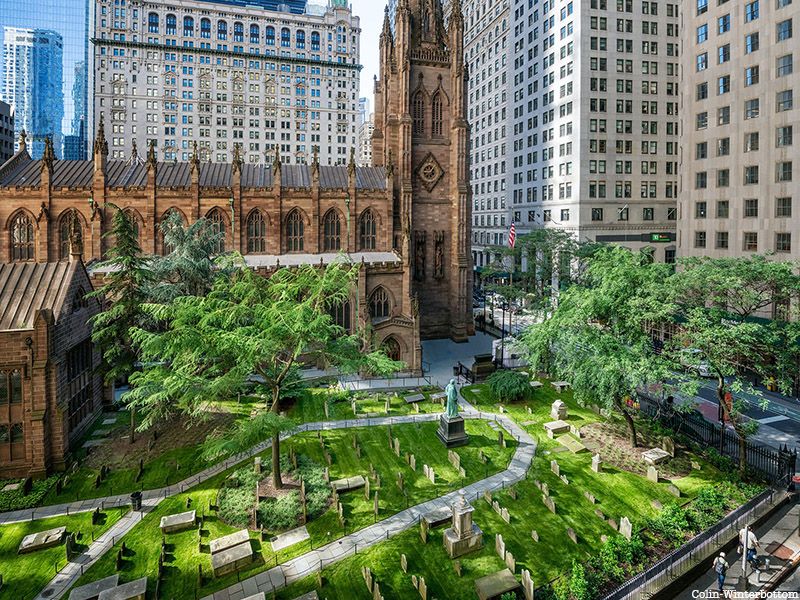
Lin Manuel Miranda penned the famous refrain “You have no control: / Who lives / Who dies / Who tells your story?” for his award-winning musical, Hamilton, about the Founding Father Alexander Hamilton. Fortunately, the legacy of slews of famous individuals — including Hamilton himself — have a palpable trail due in part to their tombstones based in New York City. Read on to learn about 10 famous people buried in New York City.

As one of the Founding Fathers of the United States, the founder of the nation’s financial system, and the country’s first Secretary of the Treasury, Alexander Hamilton was one of the most prominent figures of the American Revolution. A duel between Hamilton and his rival Aaron Burr resulted in Hamilton’s death. He was buried in the Trinity Churchyard Cemetery in Manhattan.
Hamilton’s wife, Elizabeth Schuyler, lived another 50 years after his death. During this period, she co-founded the first private orphanage in New York City. She also helped raise money for the Washington Monument. Schuyler is also buried in the Trinity Church Cemetery close to her husband. While the most notable interment of Trinity Churchyard is Alexander Hamilton, the burial ground consists of numerous tombs that date back to the 17th century, including New York City’s oldest carved tombstone. In addition to the cemetery on Trinity Place, the church established a Trinity Church and Cemetery in Upper Manhattan in 1842.
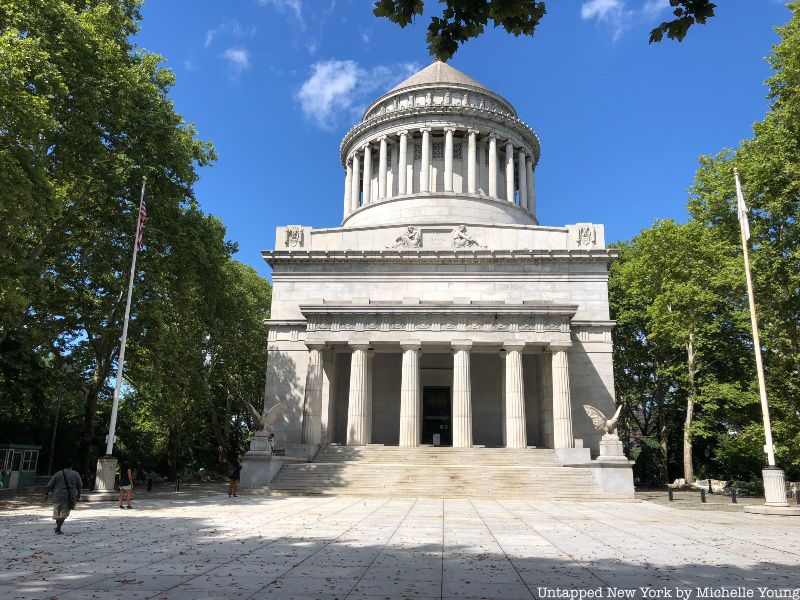
Located on the northern end of Riverside Park is the General Grant National Memorial, the final resting place of Ulysses S. Grant. The general and 18th President died of throat cancer in 1885 in Wilton, New York, at the age of 63. New York’s incumbent mayor at the time, William Russel Grace, wrote a letter to New Yorkers to garner support for the creation of a national monument in Grant’s honor. The prospect of having General Grant’s memorial in New York City drew extensive public support and a design competition took place, with an estimated reward of $500,000 to $1,000,000.
After two competitions, the design of John Hemenway Duncan, an architect who had had previous experience designing structures to celebrate the centennial anniversary of the U.S Revolutionary War, was chosen to design the tomb. Ducan’s design objective was to “produce a monumental structure that should be unmistakably a tomb of a military character.” The interior of the tomb features the twin sarcophagi of Grant and his wife Julia. This is inspired by the sarcophagus of Napoleon Bonaparte at Les Invalides in Paris.

The civil rights activist and philosopher Malcolm X was assassinated in the Audubon Ballroom in Manhattan on February 19, 1965. After the public viewing of his body, which took place at the Unity Funeral Home in Harlem, Malcolm X was buried at Ferncliff Cemetery in Hartsdale, New York, which is about 40 minutes north of New York.
Ferncliff Cemetery and Mausoleum is non-sectarian and includes three community mausoleums and a crematory. In addition to Malcolm X, the cemetery is also the resting ground of actress Joan Crawford, Late Night Show host Ed Sullivan, and many more. Furthermore, Nikola Tesla was cremated at the cemetery after he died in the New Yorker Hotel, with his ashes taken back to his home country of Serbia. Judy Garland, the actress best known for The Wizard of Oz, was once interred in the cemetery but was relocated to the Hollywood Forever Cemetery in 2017 due to her family’s wishes.

Known for the invention of the Morse code and his contribution to the single-wire telegraph, Samuel Morse died in New York City on April 2, 1872. Morse was interred at the Green-Wood Cemetery, which was originally founded as a rural cemetery in Kings County in 1838. The three-sided tomb honors Morse and his two brothers.
Built before the likes of Central Park and Prospect Park, the 478 acres of Green-Wood Cemetery were a popular space for those wanting to enjoy the lush greenery away from the bustling city. The cemetery has a naturalistic, park-like landscape, which was inspired by Pere Lachaise Cemetery in Paris and the Mount Auburn Cemetery in Cambridge, Massachusetts. Green-Wood cemetery even includes Battle Hill, the highest point in Brooklyn and the site of crucial fighting during the Battle of Brooklyn in the Revolutionary War. Green-Wood has numerous tributes to the war, such as the Revolutionary War monument, Altar to Liberty: Minvera which gazes towards the Statue of Liberty across New York Harbor.

Legendary baseball player Jackie Robinson, known for being the first African American baseball player in the Major League, passed away in his Connecticut home in 1971. Attended by over 2,500 mourners, Robinson’s funeral was held at Riverside Church, which is adjacent to Grant’s Tomb. Afterward, the procession traveled to Cypress Hills Cemetery where Robinson was laid to rest next to his son, Jackie, and mother-in-law, Zelle Isum. 25 years later, the Interborough Parkway used to transport Robinson’s body was named Jackie Robinson Parkway in his memory.
Established in 1848 as a rural cemetery, Cypress Hills Cemetery was the first non-sectarian cemetery corporation in Brooklyn and Queens. While most cemeteries at the time were situated in church courtyards, the founders of Cypress Hill sought a location that harbored a sense of tranquility and seclusion. The land they selected is on a small hill with a vantage point of the ocean. During the Civil War, the cemetery was used as a military burial for soldiers, including 235 Confederate prisoners who had died on Hart Island.
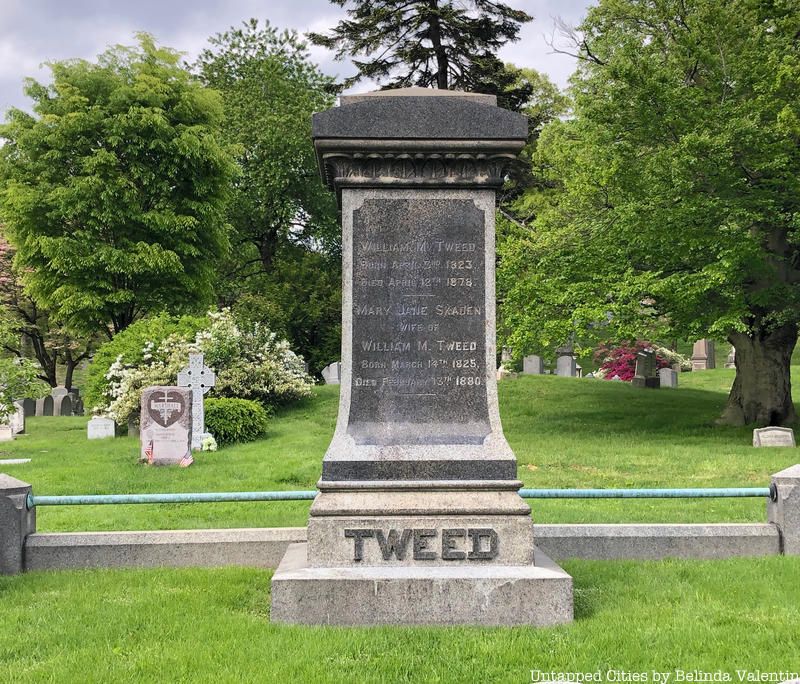
As the leader of Tammany Hall, the unscrupulous Democratic political machine of the late 19th century, William “Boss” Tweed personifies corruption and avarice. During his reign, it is estimated that he and his political cronies stole over $200 million from the government, which is equivalent to $3.5 billion today. Boss Tweed ultimately ended up in prison in 1876 and died there from severe pneumonia in 1878.
While Boss Tweed was buried in Green-Wood Cemetery, the mayor of the time, Mayor Smith Ely, refused to fly the flag at half staff, not considering Boss Tweed worthy of the honor. As The New York Times reported in 1866, “It is the ambition of the New Yorker to live upon Fifth Avenue, take his airings in the [Central] Park and to sleep with his fathers in Green-Wood.”

Widely acclaimed as one of the greatest mayors in American history, Fiorello H. La Guardia is best known for revitalizing New York City and restoring faith in City Hall. With support from Franklin D. Roosevelt, La Guardia managed to reorganize the police force and defeat the notorious Tammany Hall, thus rescinding employment based on patronage. When La Guardia died of pancreatic cancer in his home in The Bronx in 1947, he was interred at Woodlawn Cemetery, also in The Bronx.
Woodlawn Cemetery was established in 1863 when a group of businessmen convened and decided that New York City was in need of a new cemetery that could sustain its growth. Founders picked a 400-acre site in The Bronx, with advertisements boasting the cemetery was only “thirty minutes away from Manhattan” on the train from Grand Central Terminal. Over the years, the cemetery grew in popularity, especially among stars on the screen and stage such as Miles Davis and Duke Ellington. Famous Gilded Age families, such as the Vanderbilts, also fancied the cemetery. Adding to the cemetery’s grand reputation, Woodlawn is teeming with over 1,300 mausoleums, many of which were designed by renowned architects and landscape designers. The cemetery is also the final resting place for the most Titanic victims in one resting ground. The heritage of Woodlawn Cemetery culminated in its designation as a National Historic Landmark in 2011.
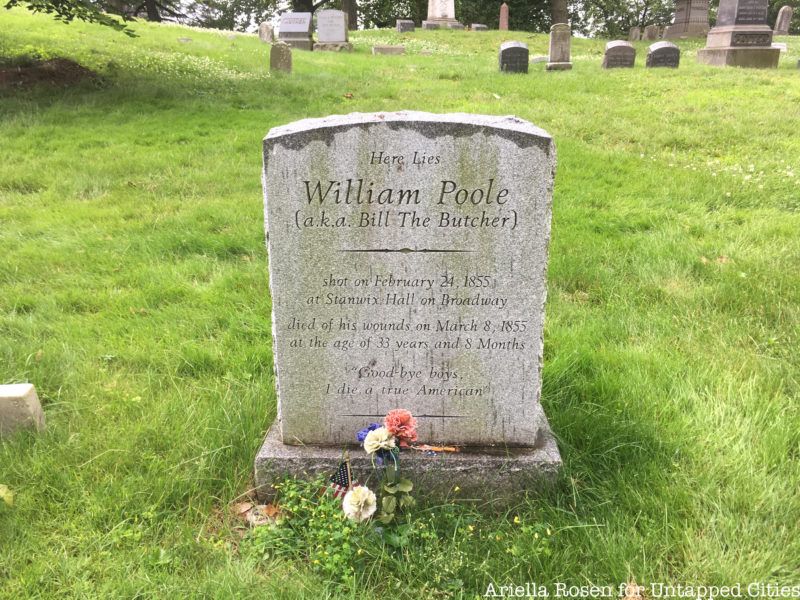
More than six feet tall and weighing over 200 pounds, William Poole was a terrifying figure in the Bowery Boys, a street gang based in New York. While Poole was a butcher by profession, it was his ferocious fighting and ruthlessness that earned him the title “Bill the Butcher.” By the mid-1850s Poole had become involved in political enforcement, with his personal gang supporting the Know-Nothing party and their anti-Irish-Catholic immigration rhetoric. Understandably, Poole became the nemesis of John Morrissey, the son of Irish Immigrants and an enforcer for Tammany Hall. The two fought in a boxing match, the initial grounds of which was Poole’s bet on Morrissey’s boxing match.
The men decided to meet at the Amos St. Dock, which is equivalent to the end of W. 10th St. today, for their fight. Morrissey showed up with a dozen of his men. Rather than showing up. Poole sent 200 of his men to beat up Morrissey and his men until fellow Tammanyites came to their rescue. Morrissey got his revenge later when he conspired to have Poole shot. Bill the Butcher was buried in Green-Wood Cemetery in an unmarked grave. Finally, in 2003, after Martin Scorsese’s inimitable depiction of Poole in the blockbuster Gangs of New York, Green-Wood Cemetery erected a gravestone in response to his revitalized infamy, with his last words etched on the stone: “Goodbye boys, I die a true American.”
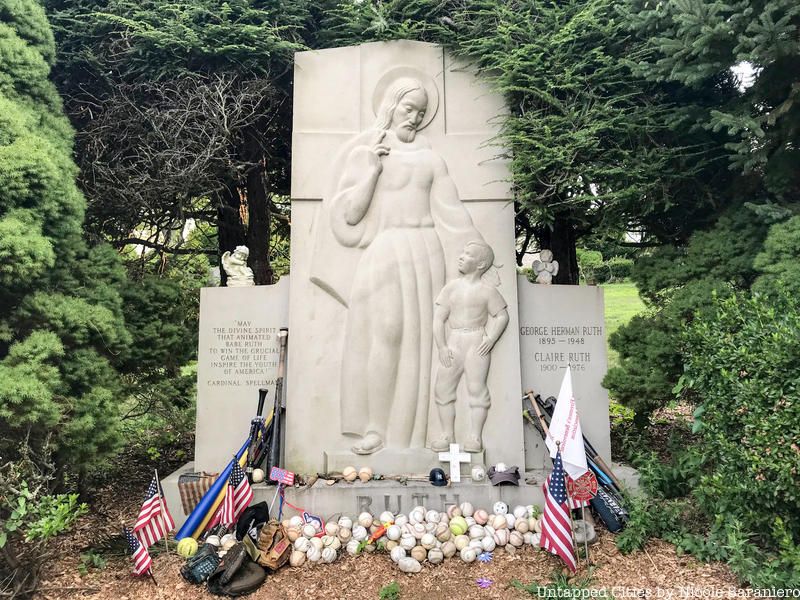
Babe Ruth, often regarded as the greatest baseball player of all time, is buried at the Gate of Heaven Cemetery, about 45 minutes north of New York City. Ruth was diagnosed with cancer in November of 1946. After a couple of years of struggling with the terminal illness, he passed on July 26, 1948, in Memorial Hospital in Manhattan.
In lieu of a funeral home, Ruth’s casket was taken to Yankee Stadium where it remained for two days, during which 77,000 people paid tribute to him. After a funeral mass at St. Patrick’s Cathedral, Ruth was buried in the Gate of Heaven Cemetery in Hawthorne, New York. Gate of Heaven Cemetery was established by the trustees of St. Patrick’s Cathedral in 1916. Since its inception, the cemetery has interred over 190,000 Catholics. Some other prominent Catholics buried there include former New York City mayor Jimmy Walker, actor James Cagney, and actress Anna Held.
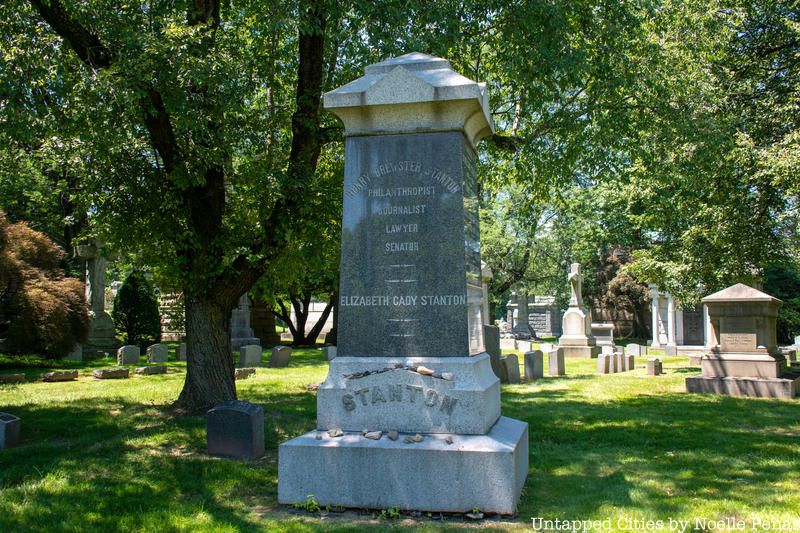
Elizabeth Cady Stanton was an American suffragist, social activist, and leader of the early women’s rights movement. Stanton was originally an active abolitionist alongside her husband during the years leading to the Emancipation Proclamation. After the Emancipation Proclamation, Stanton transferred her focus primarily to women’s rights issues, making headlines after she refused to support giving voting rights to African American men when women, black and white, were denied that right.
18 years before women were granted the right to vote in the United State, Stanton died in 1902 in her home in New York City. She was buried in the Woodlawn Cemetery in The Bronx, where a monument was erected in her and her husband’s honor. The grand tomb is yet another mausoleum in the cemetery.
Next, discover the Top 10 Secrets of Green-Wood Cemetery and Woodlawn Cemetery!
Subscribe to our newsletter